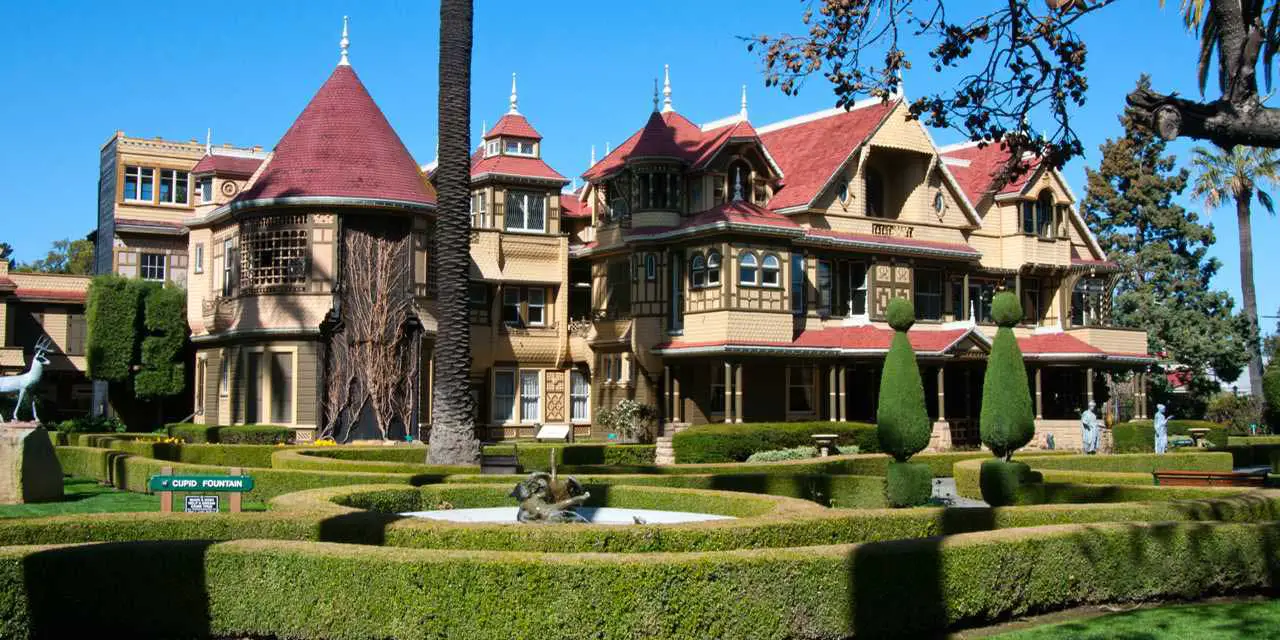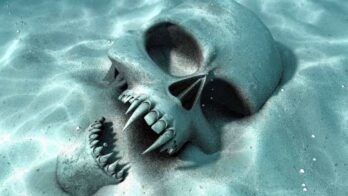The 19th-century mansion, known as the Winchester House, is an impressive and unusual structure with numerous peculiarities.
It features doors that lead nowhere, staircases that are only a few inches high, rooms divided solely by windows, and a fixation with the number 13.
Constructed without a plan, sketch, or architectural vision, the house is an illogical sequence of rooms and labyrinthine hallways. Staircases climb several levels before abruptly ending, doors lead to nonexistent rooms, and most corridors lead nowhere.
Sarah Winchester, the heiress to the vast fortune of the Winchester family, designed the Winchester House and began construction in 1884. However, the mansion was never finished due to her continuous additions and renovations.
The house’s eerie reputation is partly due to the many builders who died under suspicious circumstances or in bizarre accidents while working on the property, leading to rumors of the house being cursed and haunted.
The Gun that Won the West
The Winchester family’s story began in September 1839 in New Haven, Connecticut, when Sarah Pardee, wife of Leonard Pardee, gave birth to a daughter named Sarah.
Despite her small stature, Sarah demonstrated impressive artistic abilities, an incredible aptitude for studying, and refined oratorical skills. She was also known for her beauty and intelligence.
Although Sarah appeared sociable and amiable in the presence of acquaintances, she was, in reality, a solitary and introverted soul who often retreated to her room to converse with imaginary people, much to the bewilderment of her parents.
On September 30, 1862, Sarah married William Wirt Winchester, the only son and heir of Oliver Winchester, who owned the legendary Winchester Repeating Arms Company.
William worked alongside his father, contributing significantly to the company’s success.
In 1860, Benjamin Tyler Henry, one of Oliver Winchester’s competitors, launched the first semi-automatic weapon, the “Henry Rifle,” capable of firing a bullet every three seconds.
This new weapon was far superior to its predecessors and was adopted by the Union Army for use in both the Civil War (1861-1865) and the confrontations between the United States and Native Americans.
Inspired by Benjamin Tyler Henry’s design, William and Oliver produced the Model 1866, the first semi-automatic Winchester rifle in 1866.
The Model 1866 enjoyed immense success among soldiers, but true success came with the Model 1873, a weapon known as “The Gun That Won the West.”
Produced in over 700,000 examples, the Model 1873 was in service with the United States Army between 1873 and 1945.
It earned its nickname because of its role in the American frontier and its use by law enforcement agencies and settlers alike.
The Curse of the Winchester Family
Sarah and William’s extravagant wedding during the Civil War was a testament to the immense wealth amassed by the Winchester family through firearm sales.
Four years later, on June 15, 1866, Sarah gave birth to a daughter named Annie Pardee Winchester.
Unfortunately, Annie was diagnosed with marasmus, a severe form of malnutrition, immediately after birth. Marasmus is characterized by delayed growth, particularly in weight, and the progressive burning of fat and subcutaneous muscles.
Annie Pardee Winchester passed away just one month later, on July 25, 1866. This was a devastating loss for Sarah, and she struggled to cope in the following years.
Her mental health suffered greatly, and she isolated herself further from society, refusing to attend balls and dinners with her husband.
Her “conversations” with unseen people also became increasingly frequent, making some believe she was on the brink of madness.
In 1880, William Winchester was diagnosed with tuberculosis, and he passed away on March 7, 1881, leaving Sarah a widow.
Sarah inherited more than 20.5 million dollars after her husband’s death, the equivalent of approximately 600 million dollars in 2023.
She also inherited 50% of the Winchester Repeating Arms Company, providing her with an income of approximately 1,000 dollars a day, equivalent to nearly 30,000 dollars a day in 2023.
After her husband’s death, Sarah turned to spiritism sessions for solace.
During one of these sessions, the medium claimed to have contacted the spirits of William and Annie, who supposedly asked Sarah to abandon her home in New Haven and travel west.
There, she was to build a mansion large enough to house all the spirits of those killed with firearms produced by Winchester Repeating Arms Company.
This request resulted in Sarah moving to San Jose, California, and embarking on constructing the now-infamous Winchester Mystery House.
The Infamous Winchester House
In 1884, Sarah purchased an unfinished farm in the Santa Clara Valley and began building the infamous Winchester House.
She hired an “army” of builders and workers but refused the help of architects.
Instead, she made all plans for expansion and modification of the mansion herself, often chaotically and hurriedly, as if something was pushing her to complete the grand project quickly.
As Sarah continued to attend numerous spiritualist sessions, speculation arose that the medium was partially responsible for the unusual design of the mansion.
Perhaps the medium convinced Sarah that the spirits of those killed with firearms produced by Winchester Repeating Arms Company were responsible for her recent misfortunes.
The medium’s instructions led Sarah to believe that building the mansion would appease these spirits and provide her with the peace she desperately sought.
Convinced that the only way to calm the restless spirits was through a grand architectural project, Sarah Winchester decided that work on the mansion should never stop.
Teams of workers labored day and night, 24 hours a day, 7 days a week. With each passing hour, more and more elements were added to the house.
Balconies were transformed into rooms, windows into doors, new levels were raised, rooms were transformed into entire wings, and eventually, the Winchester House rose to no fewer than seven stories.
By 1908, the mansion had 161 rooms, including 40 bedrooms and 2 ballrooms, 47 fireplaces, 2 basements connected through a labyrinth of narrow corridors, 3 elevators, and over 10,000 windows.
A railway was built to transport construction materials inside the mansion.
However, it is not just the impressive size that draws attention to the Winchester House. The mansion has become famous for its numerous “imperfections.”
Columns were built upside down, blocked doors or doors that open into a wall, stairs ending in the ceiling, fully furnished rooms closed off between four walls without doors and windows, and an obvious obsession with the number 13.
The terrible earthquake of 1906 destroyed a large part of the house, and the last three stories collapsed.
However, the structural resistance remained unaffected. The fact that the entire house was built on a “flexible” foundation probably saved the Winchester House from total destruction.
A Prison for Tormented Souls
While for some, the Winchester House symbolizes total madness, for Sarah, it was a way to escape the “spirits that haunted her.”
This idea justifies the numerous architectural oddities, such as fully furnished rooms closed off between four walls, without windows or access doors, to trap aggressive spirits inside.
The interior labyrinth appears to have been specially designed to disorient “the spirits of the house.”
Doors leading nowhere, stairs upside down, tangled corridors ending abruptly, and interior windows all seem to be designed with a single purpose: to generate as much confusion as possible.
The period from 1918 to 1922 was tough for Sarah Winchester.
She fell into a deep depression and suffered terribly from arthritis, becoming practically “trapped” in the immense mansion. Although occasionally visited by a few acquaintances, her contact with the outside world was almost completely cut off.
On the evening of September 4, 1922, the widow Winchester retired to her bedroom after a seance.
The following day, her lifeless body was found. Sarah was 83 years old. It is said that during the last seance, the spirits communicated to her that “her work was done.”
Sarah Winchester left what remained of the Winchester fortune to her niece, Frances Marriot. However, the bank account was almost empty.
In the almost 40 years that work did not stop at the Winchester House, Sarah had spent the equivalent of approximately 500 million dollars today.
However, rumors suggest that the widow had hidden a considerable amount of money, jewelry, and gold cutlery used for dinners with her “phantasmic guests” in a safe somewhere in the house.
After her death, relatives attempted to find the mysterious treasure, but they only discovered a secret compartment in the widow’s bedroom containing some yellowed newspaper pages, toys, and a lock of hair.
The mysterious safe is likely hidden somewhere in the Winchester House’s labyrinth.
Winchester Mystery Mansion Today
In 1922, the estate spanned approximately 66 hectares, including the Winchester House, outbuildings, gardens, and land. Today, the property only consists of the main building and a few outbuildings, totaling 1.8 hectares.
In 2016, the Winchester house was declared a “historical monument,” becoming one of California’s most significant tourist attractions.
Is the Winchester house truly haunted? We have no answer to this question, but strange events have been reported in recent years.
Whether it is a clever marketing strategy or the Winchester estate is indeed a paranormal hotspot, one thing is sure: the Winchester House is a unique building in the world, not just for its impressive size but also for its chaotic, inexplicable, and bizarre architectural style.
At Ancient Theory we only use trusted sources to document our articles. Such relevant sources include authentic documents, newspaper and magazine articles, established authors, or reputable websites.
- Mary Jo Ignoffo - Captive of the Labyrinth: Sarah L. Winchester, Heiress to the Rifle Fortune. University of Missouri Press, 2010.
- Jason Hawes și Grant Wilson - The Winchester Mystery July 2005. Ghost Hunting: True Stories of Unexplained Phenomena from The Atlantic Paranormal Society. Gallery Books, 2007.
- Winchester Mystery House. wikipedia.org. [Source]
- Winchester Mystery House. winchestermysteryhouse.com. [Source]
- Jaclyn Anglis - The Terrifying True Story Of The Winchester Mystery House And The Troubled Heiress Who Built It. allthatsinteresting.com.
- Everything You Need To Know About The Winchester Mystery House. sftravel.com.
- Frank Olito - Take a look inside the famously creepy Winchester House, which has 160 rooms, staircases that lead to nowhere, and doors that open into walls. insider.com.






